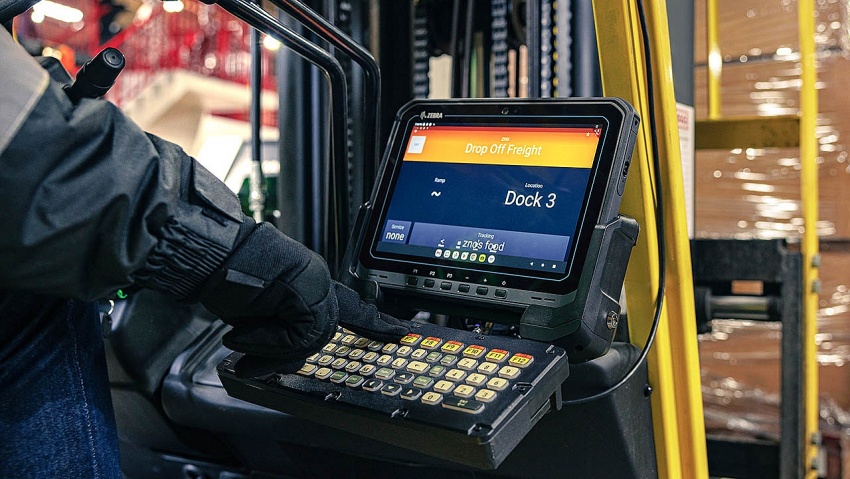Warehouse decision-makers accelerate modernisation
Zebra Technologies Corporation , a leading digital solution provider enabling businesses to intelligently connect data, assets, and people, on March 13 released the findings of its 2023 Global Warehousing Study, which showed58 per cent of warehouse decision-makers plan to deploy radio frequency identification (RFID) technology by 2028 which will help increase inventory visibility and reduce out-of-stocks.
At the press briefing with Vietnamese journalists on March 13, Christanto Suryadarma, sales vice president for Southeast Asia (SEA), South Korea and Channel APJeC, Zebra Technologies said that Vietnam is a very long country, so logistics are critical.
“So we see very significant opportunities in Vietnam to help many transport, logistics, and warehouse operators on how they can modernise warehouses,” he said.
 |
| Christanto Suryadarma, Sales vice president for Southeast Asia (SEA), South Korea and Channel APJeC, Zebra Technologies |
Zebra Technologies Corporation has been working with many top logistics partner customers, not just in logistics, but also in Vietnam. Nhat Tin Logistics is among them. Nhat Tin Logistics, one of Vietnam’s express delivery companies, has recently introduced Zebra’s scanning solution at all its branches to enhance the traceability of received parcels and keep up with increased deliveries driven by consumers’ heightened expectations within the on-demand economy.
Zebra’s comprehensive portfolio of solutions places it at the forefront of Vietnam’s digital transformation, by offering tools such as the MC94xx mobile computers, TC53/TC58 mobile computers, ET60/ET65 rugged enterprise tablets, ZD421 desktop printers, ZQ600 Plus Series mobile printers, VisibilityIQ Foresight, WS50 RFID android wearable computer, and ZT231 RFID industrial printer.
Through these innovative offerings, Zebra aims to empower enterprises in Vietnam with the ability to navigate the complexities faced by modern warehousing.
Globally and in Asia-Pacific, according to the findings, there is the trend of accelerating modernisation to manage returns. Globally, 73 per cent of warehouse decision-makers have or will be accelerating timelines of modernisation projects, with decision-makers in Asia-Pacific similarly align at 69 per cent.
This should help with returns management, which climbed to the top operational challenge cited by nearly half of warehouse decision-makers surveyed (47 per cent globally, 40 per cent in Asia-Pacific) – the study records an increase of 5 percentage points year-over-year in the Asia-Pacific region.
 |
| ET60 Tablet Warehouse Forklift, Vehicle Mount 5_4 |
“The significant growth of returns aligns with e-fulfillment growth over the last several years, and it is a mandate for change across every part of the supply chain,” said Suryadarma.
“This means warehouse leaders must modernise their operations with technology solutions to handle returns and increase agility, inventory visibility and demand forecasting to improve efficiency and make better decisions in real time.”
This comes about as the majority of warehouse decision-makers (76 per cent globally, 75 per cent in Asia-Pacific) say they are pressured to improve performance while adjusting to shifting consumer ecommerce demands.
Inaccurate inventory and out-of-stocks continue to significantly challenge productivity according to nearly 80 per cent of warehouse associates and decision-makers.
In fact, both groups – associates (82 per cent globally, 79 per cent in Asia-Pacific) and decision-makers (76 per cent globally, 79 per cent in Asia-Pacific)–acknowledge they need better inventory management tools to achieve better accuracy and determine availability. To combat these issues, a significant portion of decision-makers (91 per cent globally, 88 per cent in Asia-Pacific) are addressing this need, citing plans to invest in technology to increase visibility across the supply chain by 2028.
Warehouse decision-makers are also optimising operations to increase visibility. They are also augmenting their front-line workers by automating their warehouses to ultimately optimise their operations and increase their inventory visibility. According to a recent study by Interact Analysis, despite a recent slowdown in demand for automation projects (in part due to a reduction in warehousing construction), this demand is expected to return to growth in 2024.
The Zebra study found that seven-in-10 of warehouse decision-makers (69 per cent globally, 70 per cent in Asia-Pacific) already have or are planning to automate workflows by 2024 to support warehouse associates and shift them towards more customer-centric, high-value tasks.
More than half of warehouse decision-makers believe automation increases worker efficiency and productivity by reducing manual picking, order errors and cycle time. Meanwhile, around eight-in-10 warehouse associates globally (81 per cent) and in Asia-Pacific (78 per cent) agree using more technology and automation helps them meet or exceed productivity goals.
Complementing the rise in productivity, this empowers associates’ mentality towards their work - 8 in 10 warehouse associates (83 per cent globally, 82 per cent in Asia-Pacific) surveyed also feel more valued when their employers provide them with technology and automation tools to help them work.
Similarly, more than 8 in 10 of global (88 per cent) and Asia-Pacific (84 per cent) warehouse decision-makers say adding warehouse technologies, including devices and robotics, draw in and retain employees, which is critical during labour shortages.
More than half of the surveyed decision-makers plan to implement machine learning (52 per cent globally, 57 per cent in Asia-Pacific) and predictive analytics (59 per cent globally, 63 per cent in Asia-Pacific) software solutions in their facilities by 2028.
Notably, warehouse decision-makers are prioritising sustainability in decision-making. They are choosing solutions based on their ability to help them build sustainable operations, driven largely by regulations, energy costs or shortages along with customer, worker and investor expectations.
For example, 77 per cent of global warehouse decision-makers are focused on reducing emissions and waste, while 84 per cent of warehouse decision-makers recognise the importance of their warehouse technology solutions maximising battery life. These sentiments are echoed within Asia-Pacific as well, with 74 per cent and 78 per cent of Asia-Pacific decision-makers resonating on these areas respectively.
Other sustainable elements decision-makers prioritise today include ensuring accurate mobile device swap-out time, connecting to energy monitoring software to maximise efficiency, offering buy-back and certified refurbishment/circular economy programmes, and the use of reusable and recyclable materials.
Beyond their own operations, 81 per cent of global warehouse decision-makers (79 per cent in Asia-Pacific) also say it is important that technology vendors have sustainability measures in place for running their businesses. Ultimately, warehouses must continue to implement agile strategies to avoid inefficiencies, preserve resources, and provide employees with a performance edge.
 | Digital transformation-A key to success for retailers Amidst the acceleration of digital transformation in the country and globally, digital solutions are increasingly proving to be a key to success for retailers in Vietnam. |
 | Zebra Technologies eyes potential of logistics, healthcare, and public sectors in Vietnam Zebra Technologies, an innovator at the front line of business with solutions and partners that deliver a performance edge, is seeing good potential for future growth in transportation logistics and healthcare in Vietnam. |
 | Optimising efficiency in the workforce Businesses are still facing challenges in attracting high-qualified manpower for their technology innovations. Christanto Suryadarma, Southeast Asia Sales vice president at Zebra Technologies Asia Pacific, spoke with VIR’s Bich Thuy about optimising productivity and efficiency for the workforce. |
What the stars mean:
★ Poor ★ ★ Promising ★★★ Good ★★★★ Very good ★★★★★ Exceptional
Themes: Digital Transformation
- BIM and ISO 19650 seen as key to improving project efficiency
- Viettel starts construction of semiconductor chip production plant
- Vietnam, UN strengthen cooperation in digital technology, AI
- Vietnamese firms win top honours at ASEAN Digital Awards
- ASEAN Digital Ministers' Meeting opens in Hanoi
Related Contents
Latest News
More News
- BIM and ISO 19650 seen as key to improving project efficiency (January 17, 2026 | 10:45)
- US-Vietnam partnership targets tilapia development and soy-based aquafeed trade (January 16, 2026 | 16:50)
- Vietnam, UN strengthen cooperation in digital technology, AI (January 16, 2026 | 16:48)
- Shopee and TikTok Shop account for 8 per cent of Vietnam’s retail market (January 16, 2026 | 00:00)
- Sanofi, Long Chau Pharmacy relaunch medicine blister pack collection initiative (January 15, 2026 | 15:35)
- Viet Industry 2026 exhibition scheduled for September (January 09, 2026 | 09:51)
- Cathay kicks off ‘80 Years Together’ anniversary celebrations (January 08, 2026 | 11:05)
- Electronics drive Vietnam’s trade growth as exports hit record in 2025 (January 07, 2026 | 10:23)
- Vietnam’s domestic market to grow 10-12 per cent from 2026-2030 (January 06, 2026 | 17:58)
- Irish beef gains access to Vietnamese market (January 06, 2026 | 16:51)

 Tag:
Tag:

























 Mobile Version
Mobile Version